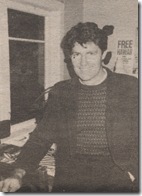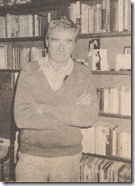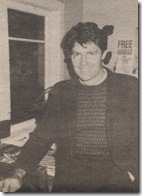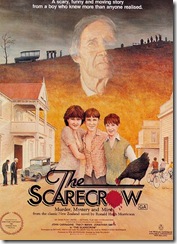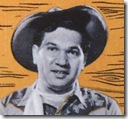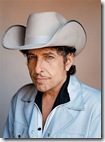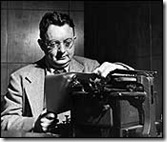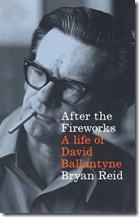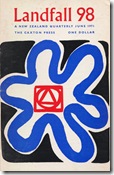The history of music magazines in New Zealand goes back to colonial times, and of course became more complex from the late 1970s. Triad’s connection with Rip It Up is provided by Charles Baeyertz’s grandson Simon, who was a key supporter while at Festival Records, and a Cha-Cha contributor; his brother Paul briefly played keyboards in Space Waltz and taught me acoustics at university.
FACING THE MUSIC: Charles Baeyertz and the Triad, by Joanna Woods (Otago University Press, Dunedin: 2008)
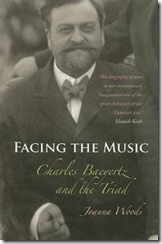 Charles Baeyertz was New Zealand’s critic-at-large, and larger than life. As founder and editor of the Triad, for more than 30 years he championed and excoriated New Zealand culture like a megalomaniacal polymath. He was a crusader for the arts, indefatigably travelling the country in pursuit of excellence. If he found it, no practitioner could have a more enthusiastic advocate. But if his standards weren’t met – especially by professionals – he wasted no breath on politesse in his disapproval. His criticism was delivered with a swashbuckling relish. Late-Victorian New Zealand is usually portrayed as being dominated by pragmatic pioneers and philistines, and a small society in which feelings and reputations could so easily be bruised that discretion was a synonym for discourse. Publish and be damned could have been his motto: he did, and he often was.
Charles Baeyertz was New Zealand’s critic-at-large, and larger than life. As founder and editor of the Triad, for more than 30 years he championed and excoriated New Zealand culture like a megalomaniacal polymath. He was a crusader for the arts, indefatigably travelling the country in pursuit of excellence. If he found it, no practitioner could have a more enthusiastic advocate. But if his standards weren’t met – especially by professionals – he wasted no breath on politesse in his disapproval. His criticism was delivered with a swashbuckling relish. Late-Victorian New Zealand is usually portrayed as being dominated by pragmatic pioneers and philistines, and a small society in which feelings and reputations could so easily be bruised that discretion was a synonym for discourse. Publish and be damned could have been his motto: he did, and he often was.
Caution was never likely. Baeyertz was born in Melbourne in 1866 to parents who had alienated their families: his father for marrying a Jewish bride, his mother for marrying a non-Jew. Charles senior was the bank manager in a rural settlement, quickly becoming a big man in a small town. But at the age of 28 he died in a hunting accident; his widow Emilia had little family support to raise two children under five. Having half-heartedly converted to Christianity on her marriage, the grieving widow now embraced her new faith with a dramatic intensity. Putting the precocious Charles into boarding school, she became internationally renowned as an evangelical preacher.
In a biography of scrupulous accuracy, Joanna Woods only alludes to the paternal influence on Baeyertz. With little evidence as to his father’s character, Woods makes no more than a suggestion that he may have inherited his father’s risk-taking and flamboyance. Discussing the influence of Baeyertz’s mother, however, she is on more certain ground:
[The] lasting impact of Emilia’s intensity, and the extent to which Charles followed her example, are demonstrated by the ‘Apostolic fire’ which imbued his cultural mission to New Zealand and prompted him to found his critical magazine, the Triad. Strains of his mother’s evangelism resound through its pages, not only in his exacting musical and literary reviews, but also in this many pronouncements on the moral dangers of ‘a prevalence of bad English’ and his dire warnings on the evils of faulty diction. (pp21-22)
Friends say that Baeyertz was ‘maddeningly good at everything’. He had a formidable memory, vast expertise in music and was conversant in many languages. Boarding school is where he made his debut as a journalist and publisher, in a style to which his followers would become accustomed.
Baeyertz launched a school magazine, the Collegian Herald, and edited it with ‘a ready wit and scant regard for the feelings of others.’ In a parody of a court report he mocked the school’s German master, especially for his lapses in hygiene. The headmaster responded with wisdom: the idea of a school magazine was worthwhile, but it would be produced by the school (which it is to this day).
Largely self-educated, but with a sense of humour that owed little to his earnest upbringing, Baeyertz had few career ambitions other than a desire to be involved in music. His German name helped, and he became a church choirmaster and organist. He was lucky to be a young adult in the 1880s, when Melbourne was at a cultural peak and booming economically. Many overseas performers were visiting, and there was a wide variety of light opera, theatre and vaudeville on offer; Gilbert and Sullivan operettas were especially popular.
Property speculation was also rife, and when the bust occurred, Baeyertz was an early victim. With a young wife and three children, he decided to start again in Dunedin, a city enjoying the cultural after-effects of the 1889-1890 New Zealand and South Seas Exhibition. He was determined to establish himself in a career that would make use of his love and knowledge of music. Although his talents – in an era when much social interaction revolved around music – were not exceptional, and he had no formal qualifications, he had a profound understanding of music, especially the technical aspects of performance.
Dunedin had a surfeit of music teachers, however, and Baeyertz didn’t have the gravitas to suit the university, so he decided to promote himself through music journalism. A series of wide-ranging, well-informed articles for the Otago Witness led to his appointment as a music and theatre critic of the Otago Daily Times. He quickly picked a fight with a prominent columnist, showing off his superior technical knowledge of music.
Baeyertz saw a gap in the market for an arts magazine, concentrating especially on music. His timing was good: New Zealand was enjoying a period of prosperity under the Liberals, and was about to receive many visits from international opera companies and musicians. His only competition was the ‘dignified’ New Zealand Music Monthly published out of Balclutha, which concentrated on brass bands – and failed after three years.
He may have had worthy aspirations for improving the quality of the arts in New Zealand, but in contrast to many others driven by their passion, Baeyertz was a businessman: above all, he wanted his magazine to sell. Unlike the recent, short-lived, Zealandia – or Australia’s successful Bulletin – Baeyertz didn’t pander to the nationalistic sentiments of his readers. His magazine would be international in its outlook, and to this end he quoted liberally from overseas magazines.
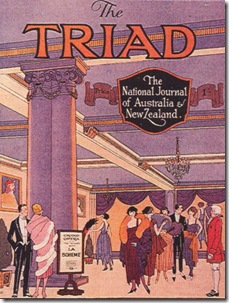 Launched in 1893, the Triad was an arts magazine, not a literary journal, with an emphasis on music in particular. Baeyertz was a critic interested mostly in lifting standards, rather than promoting cultural nationalism in a fledgling colony. He enjoyed being a judge, and was an enthusiastic supporter of the amateur speech and music competitions beginning to flourish on both sides of the Tasman. Being an adjudicator was the perfect secondary career: he could reward effort, promote standards – and himself – and people were forced to listen. When it came to professional performers, even international stars such as Nellie Melba, Baeyertz took delight in socialising with them but didn’t pull his punches when the time came to cast judgement. His manifesto shared his mother’ crusading spirit:
Launched in 1893, the Triad was an arts magazine, not a literary journal, with an emphasis on music in particular. Baeyertz was a critic interested mostly in lifting standards, rather than promoting cultural nationalism in a fledgling colony. He enjoyed being a judge, and was an enthusiastic supporter of the amateur speech and music competitions beginning to flourish on both sides of the Tasman. Being an adjudicator was the perfect secondary career: he could reward effort, promote standards – and himself – and people were forced to listen. When it came to professional performers, even international stars such as Nellie Melba, Baeyertz took delight in socialising with them but didn’t pull his punches when the time came to cast judgement. His manifesto shared his mother’ crusading spirit:
The critic who [n]ever expresses outright satisfaction with anything but the best in art fails in his duty to himself, to the artist and the art concerned, and to the public ... The highest standards are the only true criteria of intelligent and honest criticism. The critic should judge always as though he heard the artist for the first time in his life, in some city in which he was a stranger. It is not for him to inquire who Mr Noodle’s relatives are, or who taught Miss Shrill to make such offensive noises. He is to judge the artist, as a craftsman judges a machine, by comparison with the best of its kind. (p86)
Baeyertz was proud that he (almost) never accepted reviewer’s tickets to a concert. That way, his freedom of speech was uncompromised. He especially enjoyed deflating the pompous and over-hyped, a famous example being the 1908 tour by the statuesque Australian contralto Clara Butt. She came supported – financially and on the stage – by her wealthy jeweller husband, the baritone Kennerly Rumford. Baeyertz was offended by their commercialism and exploitation of the family angle, and ranted as if confronted by Posh and Becks singing ‘Nessun Dorma’: ‘The masses, the philistine, the satiated bourgeois were prepared: and for them everything was arranged. No feeling of disgust was awakened by this display of home and family life, exhibited as a draw for the populace, not even when the latest baby was put on the placards’ (p123). If the pre-publicity was repellent, the actual music turned him almost apoplectic:
The whole programme was a concession to the bourgeois. A snack of Schumann, a gout of Gluck, and happy handful of Handel [... and then] the joy-filled audience paddled in the shallow water of English drawing-room songs. [...] Mrs Rumford owns a big voice, organ-like in quality, but inferiorly played. There is a bad break in the voice. Her notes are coarse and lack polish and roundness. There is no continuous flow of sound [...] she makes mincemeat of a song. (p124)
The uproar that followed saw the Triad’s sales boom, but inevitably a policy of outspokenness would bring trouble. The magazine’s most famous day in court was in 1913 after the singer and vaudeville promoter John Fuller was accused of having a voice like a ‘pig’s whistle’. The courtroom scene could have been from Gilbert and Sullivan: Fuller appeared in the witness box with a tuning fork and some sheet music. Observing was the complete cast of Pink Dandies, and the room ‘rocked with laughter’ for three hours. Baeyertz’s main defence – that a ‘pig’s whistle’ was defined as merely meaning ‘a low whisper’ – won him the case, and the Triad received wonderful publicity.
The writer of the ‘pig’s whistle’ line was Frank Morton, a hard-drinking, Australian womaniser who happened to craft stylish prose. Baeyertz first came across Morton criticising the Triad, and saw the possibility of ‘a splendid enemy’. Soon, Morton would become the magazine’s star writer, boosting circulation just as Baeyertz’s energy was flagging. Morton was prolific, versatile and outrageous. He brought a more literary quality to the magazine, in his writing and the topics he chose to cover. Women readers in particular loved the persona portrayed by Morton (and his many pseudonyms), and he wasn’t shy of using his fame.
Understandably, Woods has concentrated on the Baeyertz that emerges from the Triad, which is where he left a paper trail. His vigorous, unfettered writing displays his passions, but little about the man himself. But thanks to Woods’s determined research, Baeyertz the person is shown to be as colourful as his prose: tragedy, drama and romance were all set to a grandiose soundtrack, though destructive to his family. Woods writes with wry humour, though her discretion occasionally undersells the narrative. An example is when Baeyertz, his first marriage over, sets off on a voyage to the United States with the love of his life. The year is 1919, the influenza pandemic has just peaked. Although he and Mildred Carey-Wallace never married – and scandalously had a child out of wedlock – the trip was to be like an extended honeymoon. It was also an opportunity for Baeyertz, like Charles Foster Kane, to further his de facto wife’s musical career. They would have been in high spirits, writes Woods ...
Their feelings, however, are not recorded. Instead, all that remains is a terse entry in Charles’s diary in which he noted, without comment, the sequence of devastating events that followed:
4.6.1919 Left for America. Sonoma.
9.6.1919 Mildred died. 11.45pm.
10.6.1919 Mildred buried. Pango Pango. (p186)
Undoubtedly Baeyertz was devastated; certainly, the reader is stunned. He ‘carried on doggedly with his programme,’ his feelings only being reflected in his jaundiced reports for the Triad. With his journalism as the sole available source, Woods sensibly avoids speculation or melodrama, but it is not the only occasion when a climax could support a more emphatic cadence.
What legacy did Baeyertz leave behind in New Zealand culture? Directly, not much, especially when compared to another largely forgotten, autocratic cultural gatekeeper, James Shelley of the National Broadcasting Service. The amateur string orchestras would have kept scratching away without Baeyertz, but Shelley gave them a goal in the National Orchestra. The musty editions of the Triad reveal its era to have a cultural excitement which is rarely portrayed. Perhaps the magazine’s lasting influence was literary: both Katherine Mansfield and bookish newspaperman Pat Lawlor admired Frank Morton, and Robin Hyde was a dedicated reader.
Alan Mulgan described Baeyertz walking the streets ‘with the standing and authority of an institution.’ In the last 40 years, essayists such as Monte Holcroft, Hamish Keith and John M Thomson have celebrated Baeyertz and the Triad but such a colourful character deserves more widespread notoriety. Now that Woods has dedicatedly sifted the archives for an engrossing biography, a television costume drama is in order (and pigs will whistle). The pitch could be ‘The Governor meets My Fair Lady’.
(First published in JNZL: Journal of New Zealand Literature, #26, 2008)
